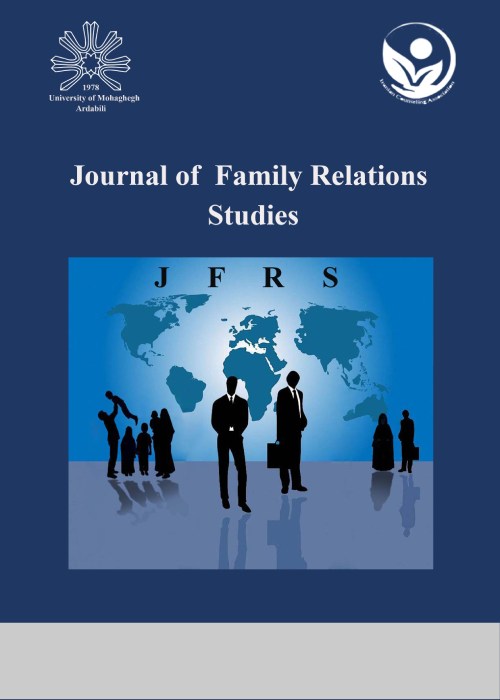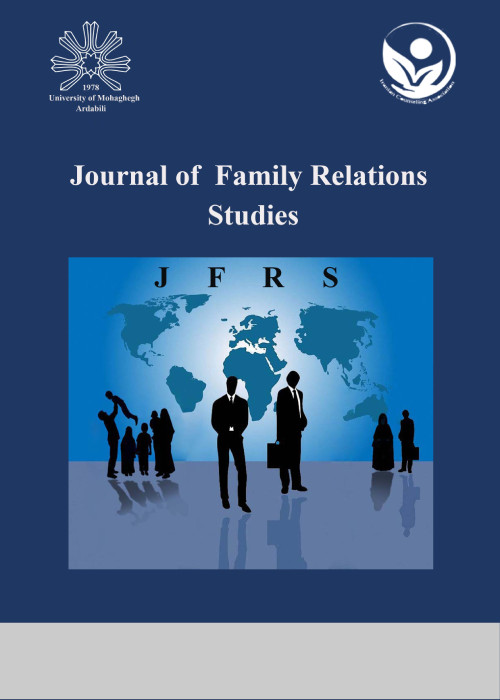فهرست مطالب

Journal of Family Relations Studies
Volume:3 Issue: 8, Jan 2023
- تاریخ انتشار: 1402/01/19
- تعداد عناوین: 6
-
-
Pages 4-12ObjectiveRemarriage to an ex-spouse is one of the most challenging decisions for any man or woman after divorce. It is associated with both positive and negative challenges and consequences. Therefore, this research aimed to identify the consequences and challenges of remarriage with an ex-spouse from the perspective of women and men in Yazd city.MethodsThe method of this research was qualitative with grounded theory study. The research populations were all men and women who had remarried with their ex-spouse. The research sample was selected using purposive and snowball sampling based on the inclusion and exclusion criterias. Semi- structured interview was counducted on them. hence, ten people (7 women and 3 men) were interviewed before theoretical saturation. The results were analyzed using MAXDQDA software.ResultsAfter collecting and coding the data using the Strauss and Corbin method, which was based on open, axial, and selective coding, 292 concepts, 38 sub-categories, eight main categories, and one core category under the title "Family Reestablishment" were obtained. The main eight categories were Social Degradation, Mental Withdrawal, Urge to Remarry, Comprehensive Mediation, Gradual Restoration, Conscious Return, Psychological Hopelessness, and Return of Peace.ConclusionResults showed that when the family breaks up, various reasons and grounds make them to return to their former life. But in this way, they try to make a successful return with less challenges through changes in their behavior or in the family foundation.Keywords: Remarriage to an ex-spouse, Family Reestablishment, Grounded Theory
-
Pages 13-23ObjectiveGiven that cultural perceptions regarding marriage are shifting and the pathways to marriage are more complex, scholars interested in marital rela tionships have recently focused their attention on understanding the individual’s attitudes, values, and beliefs regarding marital transitions and relationships, and how those beliefs may alter individual and relational behaviors. In this article we have tried to rely on various theoretical approaches to explain marital meaning - particularly the theory of symbolic interactionism and concept of "Marital Paradigm" as the central concept of the study - to create an appropriate model that provides a different explanation for differences in individual’s marital paradigms.MethodsThe model explains the marital paradigm using four groups of factors. Our basic idea was marital paradigm which was a production of encountering four groups of factors including personal, structural, cultural and commutative factors. The model was tested by a secondary analysis - based on dataset from a survey conducted in 2016 in Tehran - and has been confirmed by results of this study.ResultsThe results showed that variables such as religiosity, age, income, marriage duration and gender directly affect the marital paradigms of Iranian people.ConclusionGiven that paradigm differences may be the root of many marital problems, the present study introduces a new form of homogamy called "paradigmatic homogamy” as a solution. This concept considers the paradigmatic coordination of couples as an important factor in marital strength, and suggests that individuals learn about the partner's paradigmatic characteristics before entering into marriage. These characteristics can be traced to the six dimensions of the marital paradigm that we discussed in this study.Keywords: Marital Paradigm, Marital Role, Marital Rubric, Marital Context, Marital Permanence
-
Pages 24-31Objective
The present study conducted to investigate the role of anxiety mediation in the relationship between psychological capital and mindfulness in obese candidates for bariatric surgery.
MethodsThe study method was a descriptive correlational research. The statistical population of the research included all women candidates referred to Rasoul Akram Hospital in Tehran in the year 1400 (March 21, 2021 – March 20, 2022) for minimal invasive bariatric surgery. Among them, a number of 250 women were selected as samples through convenience non-random sampling. The research tools were Psychological Capital Questionnaire (Luthans et al. 2007), Freiburg’s Mindfulness Inventory - short form (Wallach et al. 2006) and Beck Anxiety Questionnaire (Beck et al. 1993). Structural equation modeling was used for analyzing the data. The gathered data were analyzed using two statistical analysis software SPSS Version 26 and LISREL Version 8.8.
ResultsThe results showed that the fit indices are in acceptable level and the suggested model has optimum fit index.
ConclusionConsidering the important role of mindfulness and anxiety in predicting the psychological capital, trainings and interventions aiming increase in mindfulness and decrease in anxiety should be included in preoperative plans dedicated for bariatric surgery candidate.
Keywords: Psychological capital, mindfulness, anxiety, bariatric surgery -
Pages 32-39ObjectiveThis paper expounds the role of family relationships and conflict resolution styles in marital burnout of couples seeking a divorce in Minab city.MethodsThis is descriptive and correlational research. The study’s statistical population consists of the total number of married couples in Minab city in 2022 who were applieded for divorce. Using random sampling, 162 people were selected. The participants were asked to fill out the following questionnaires: the Couple Burnout Measure (CBM); The Rahim Organizational Conflict Inventory-II (ROCI II), and The Brief Family Relationship Scale (BFRS.ResultsPearson's correlation coefficient and simultaneous multiple regression were used to analyze the study findings and examine the relationships between research variables. The study results indicated that family relationships and conflict resolution styles are significantly correlated with marital burnout (P < 0.05).ConclusionResults analysis indicated that there was a significant relationship between family relationships, conflict resolution styles, and marital burnout highlighting divorce as one of the primary family trauma which brings about disintegration on a personal, familial, and social level. Therefore, the identification of the factors contributing to couples’ dissatisfaction and burnout have high significance since it affords us to take effective measures to prevent divorce and improve couples’ marital life.Keywords: family relationships, Conflict Resolution Styles, Marital burnout, couples, divorce
-
Pages 40-46ObjectiveConsidering domestic violence occurs in the context of marital relationship, it seems necessary to examine the individual characteristics of each couple in the occurrence of this phenomenon. Therefore, the purpose of this study was Comparison of communication skills, Cognitive Emotion Regulation Strategies and Communication Patterns in Women with and Without Experience of Domestic Violence.MethodsThe present study was an analytical-comparative study. The statistical populations of this study were all women of Rasht city in the 2018 year. Among these women, 120 persons were considered as a research sample; of these, 60 people in the group of women with experience of violence were selected using available sampling method and 60 people in the group of women without experience of violence were selected using cluster sampling method. Data measurement tools in this study were Communication Skills Questionnaire (CSTRQ), Marital Relationship Patterns Questionnaire (CPQ) and Cognitive Emotion Regulation Questionnaire (CERQ). The data of this study were analyzed using independent t-test in SPSS 21.ResultsThe results showed that there was a significant difference between communication skills and communication patterns of constructive interaction and withdrawal-belonging pattern in women with and without experience of domestic violence (P <0.05). However, no significant difference was observed between the two groups in terms of communication pattern of mutual avoidance and cognitive regulation of emotion.ConclusionConsidering the important role of communication skills and patterns in the occurrence or prevention of domestic violence, communication skills training in premarital counseling and marital counseling seems necessary.Keywords: communication skills, Communication Patterns, Cognitive emotion regulation strategies, Domestic Violence, women
-
Pages 47-59Objective
The aim of present study was to determine the predictors of quality of marriage and also test the mediating role of subjective well-being in the relationship between four existential domains and quality of marriage.
MethodsIn terms of purpose, this study was an applied research and used structural equation modeling. The statistical population of research included all married people of Kermanshah city in 1400. The sample consisted of 441 married men and women who were selected by convenience random sampling method and questionnaires were completed by electronic survey method. Dehshiri Spiritual well-being Scale , Norton Quality of marriage Index and Warwick-Edinburgh subjective well-being Scale were used to collect data. SPSS and AMOS software version 26 were used to analyze the data and the data were analyzed using the structural equation model method.
ResultsThe results of structural equation showed that relationship with self and relationship with nature have a significant relationship, both directly and indirectly, with the quality of marriage. subjective well-being has only directly and relationship with God only indirectly related to the quality of marriage, so that relationship with God through subjective well-being has a significant relationship with quality of marriage.
ConclusionThe results of the research showed that a good relationship with God leads in good relationships with self and nature, and results of these good relationships strengthen people’s subjective well-being, and this in turn increases the quality of marriage. As we know, one of the dimensions of consultants' work is prevention. Therefore, it is recommended that counselors and psychologists provide the necessary training on establishing and enriching the four existential relationships to clients who seek premarital counseling or in individual counseling to clients. Counselors and psychotherapists in evaluating the problems of couples, as one of the variables affecting marital relationships, should also consider the extent of the four existential relationships and try to solve the problems of couples, to enrich these relationships.
Keywords: Four existential domains, Relationship with god, Relationship with self, Relationship with others, Relationship with nature, subjective well-being, Quality of marriage


